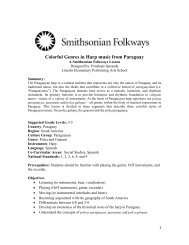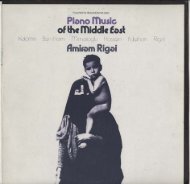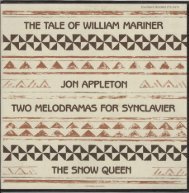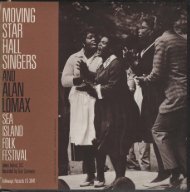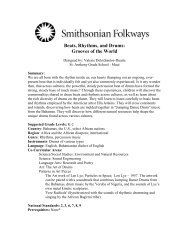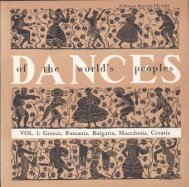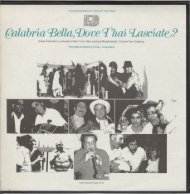Said, who pLayed <strong>the</strong> nai in <strong>the</strong> previous sarnai selection.The musical as well as religious contribution <strong>of</strong>this family to <strong>the</strong> East African Muslim community ispr<strong>of</strong>ound.Dhikiri is not regularly performed in Iamu. Severalinformants encouraged me to attend a dhikiri performance,but I could not locate one until one night, inMambrui, <strong>Kenya</strong>, I happened to be present whendhikiri was performed. The mosque in Mambrui is asatellite <strong>of</strong> <strong>the</strong> Riadha Mosque in Iamu, being notedfor its musical rituals. Several <strong>of</strong> its teachers are outstandingmusicians.Dhikiri is known to occur in many parts <strong>of</strong> <strong>the</strong> Muslimworld. It is supposed to be based upon <strong>the</strong> Quranicinjunction, "Remember God with frequent remembranceand glorify Him morning and evening." Thismandate has evolved into recitations that involve <strong>the</strong>chanting <strong>of</strong> songs, accompanied by constant repetition<strong>of</strong> <strong>the</strong> name <strong>of</strong> Allah. In some places <strong>the</strong>se recitationsreach a high pitch <strong>of</strong> intensity, due at least in part to<strong>the</strong> hyperventilation that results from aspirating "Allah"A zeJe is a procession, not a styLe <strong>of</strong> music, yet inlamu some music was used exclusively in zeJe. Hymnsfrom Mauiidi ya Kiswahili and kasida were alsoperformed, but exclusively zeJe songs were especiallypopular. They are performed in grand processionsthrough <strong>the</strong> streets <strong>of</strong> <strong>the</strong> town before crowds <strong>of</strong> womenand children and an occasional tourist who is attractedby <strong>the</strong> music. ZeJe usually precede and <strong>of</strong>ten followa ritual called ziara, which is a visit to <strong>the</strong> grave<strong>of</strong> an honored person to sing praises <strong>of</strong> <strong>the</strong> Prophetand to heap blessings upon <strong>the</strong> head <strong>of</strong> <strong>the</strong> deceased.Some zeJe were more elaborate than o<strong>the</strong>rs, <strong>the</strong> largest<strong>of</strong> all being <strong>the</strong> one to <strong>the</strong> gravesite <strong>of</strong> Habib Saleh at<strong>the</strong> end <strong>of</strong> mauiidi, <strong>the</strong> celebration <strong>of</strong> <strong>the</strong> birth<strong>of</strong> <strong>the</strong> Prophet, sponsored by <strong>the</strong> Riadha Mosque. Themany visitors to Iamu for <strong>the</strong> festival contribute greatenthusiasm to <strong>the</strong> zeJe, each group performing musicassociated with its own village or school. One <strong>of</strong> <strong>the</strong>most popular songs is a justification <strong>of</strong> singing mauiidi,directed at those who oppose such "noisy" displaysThe chants sung by a group <strong>of</strong> school boys whoprecede <strong>the</strong> procession and by <strong>the</strong> men bearing <strong>the</strong>c<strong>of</strong>fin <strong>of</strong> a deceased person to <strong>the</strong> burial ground areamong <strong>the</strong> most sensitive musical lines to be heardin Iamu. The contrast between praise and sorrow asexpressed in <strong>the</strong>se songs is a clear expression <strong>of</strong> <strong>the</strong>religious convictions that permeate Iamu society and<strong>the</strong> tragedies that affect <strong>the</strong> lives <strong>of</strong> every man andwoman.The body <strong>of</strong> <strong>the</strong> deceased is prepared for <strong>the</strong> burialat home and is <strong>the</strong>n taken to a mosque where familySide 2, Band 1DhikirlBand 2ZeJeBand 3Funeral Processionover and over again. On occasion, some may experienceseizures by <strong>the</strong> spirit or indulge in self-flagellationduring dhikiri.In Mambrui, <strong>the</strong> performance <strong>of</strong> dhikiri reached apeak <strong>of</strong> emotional intensity and one seizure did occur,but most <strong>of</strong> <strong>the</strong> performance was marked more by <strong>the</strong>involvement <strong>of</strong> <strong>the</strong> men in <strong>the</strong> joy <strong>of</strong> <strong>the</strong>ir praises andin <strong>the</strong> beauty <strong>of</strong> <strong>the</strong> hymns. The soloist in <strong>the</strong> first songon this recording is Mohammad Khitami, a youngteacher, scholar and musician who was teaching inMalindi at <strong>the</strong> time. He is a son <strong>of</strong> one <strong>of</strong> <strong>the</strong> leadingdescendants <strong>of</strong> Habib Saleh. The reciter and leader <strong>of</strong><strong>the</strong> second song is Hussein Badawy, <strong>the</strong> singer andcomposer <strong>of</strong> <strong>the</strong> kasida heard on side 1, band 2, <strong>of</strong>this record. The combination <strong>of</strong> <strong>the</strong>se two men toge<strong>the</strong>rwas electrifying.ZeJe being led by teachers dancing enthusiastically<strong>of</strong> overenthusiastic devotion. Today, <strong>the</strong>re are fewsuch opponents in Iamu, but in <strong>the</strong> past such resistancewas much more widespread. Songs like this one reflecta tension that was once a serious problem for <strong>the</strong>teachers and leaders <strong>of</strong> <strong>the</strong> community.and friends ga<strong>the</strong>r for prayers. Immediately <strong>the</strong>reafter<strong>the</strong> c<strong>of</strong>fin is borne to <strong>the</strong> graveyard for interment. Theboys walk first and are followed closely by <strong>the</strong> menwho are continuously replacing each o<strong>the</strong>r as pallbearers.At <strong>the</strong> grave <strong>the</strong> body is placed on a terracedug out <strong>of</strong> <strong>the</strong> side <strong>of</strong> <strong>the</strong> grave, lying on its side facingMecca.After <strong>the</strong> burial special prayers and praises are sungei<strong>the</strong>r at <strong>the</strong> homes <strong>of</strong> close relatives or in mosques.Women close to <strong>the</strong> deceased must remain indoorsand mourn for at least three days.12
Volume IIISecular <strong>Music</strong>Secular music in lamu is clearly marked by <strong>the</strong>contexts in which it occurs. The first and most importantcontext is <strong>the</strong> wedding. Although marriage iscontracted in <strong>the</strong> presence <strong>of</strong> a religious leader, <strong>of</strong>tenin a mosque, <strong>the</strong> great majority <strong>of</strong> events that occurduring a wedding are non-religious, being clearlyviewed as separate from <strong>the</strong> short, formal ceremonyitself.Men dance goma, kirumbizi and, on occasion,chama. Women process in <strong>the</strong> street canying giftsand dancing vugo and, on <strong>the</strong> morning after <strong>the</strong> consummation<strong>of</strong> <strong>the</strong> marriage, <strong>the</strong>y carry msuwaki to <strong>the</strong>groom's home. During <strong>the</strong> previous night <strong>the</strong>y dancechakacha nonstop until dawn. Meanwhile, <strong>the</strong> menhave been listening to tarab while enjoying cups <strong>of</strong>tea.Chama and goma have also become associatedwith national patriotic celebrations, being performedduring public ceremonies and on <strong>the</strong> streets throughouta holiday.The instruments used in <strong>the</strong>se dance forms neverappear in mosques or during religiOUS ceremonies.This distinction alone is enough to clearly mark <strong>the</strong>separation <strong>of</strong> sacred and secular music in lamu.Coma is associated with Siyu and Faza. It was seenonce in lamu itself and that was when visitors from <strong>the</strong>seo<strong>the</strong>r towns performed it on <strong>the</strong> occasion <strong>of</strong> <strong>the</strong> annualcelebration <strong>of</strong> maulidi in front <strong>of</strong> <strong>the</strong> Riadha Mosque.A space about twenty-five feet square is roped <strong>of</strong>ffor <strong>the</strong> performance. Chairs for special guests may beplaced inside <strong>the</strong> ropes on one side <strong>of</strong> <strong>the</strong> squarewhile <strong>the</strong> accompanying ensemble is placed on <strong>the</strong>opposite side. The instrumentation consists <strong>of</strong> a goma,a large single-headed drum standing on <strong>the</strong> ground onits own feet, a chapuo, an utasa and a zumari. O<strong>the</strong>robservers stand outside <strong>the</strong> ropes. The dancers, dressedin white gowns called kanzu, and small hats calledkojia, assemble in a line, Single file, shoulder toshoulder, along <strong>the</strong> third side. They each carry a caneabout four feet long, called bakora, in <strong>the</strong> right hand.The dance is divided into two parts as can bediscerned on <strong>the</strong> recording. During <strong>the</strong> first part <strong>the</strong>dancers quietly shift <strong>the</strong>ir weight from left to right whilegesturing with <strong>the</strong> canes. The dancer begins <strong>the</strong>sequence holding <strong>the</strong> cane straight up along his rightside. On <strong>the</strong> second half <strong>of</strong> a count <strong>of</strong> eight he lifts <strong>the</strong>cane up to a forty-five degree angle in front <strong>of</strong> himself.Simultaneously with a heavy thud being struck on <strong>the</strong>goma, he snaps his wrist and <strong>the</strong> cane away from hisbody. He <strong>the</strong>n brings it down again beside his body. Atintervals <strong>the</strong> group sings short songs.Side 1, Band 1GomaBand 2ChamaDuring <strong>the</strong> second half <strong>of</strong> <strong>the</strong> dance <strong>the</strong> drum beatis faster, <strong>the</strong> gesture with <strong>the</strong> canes is not done, andno songs are sung. On ano<strong>the</strong>r occasion than <strong>the</strong> oneon this recording, various o<strong>the</strong>r gestures wereperformed with <strong>the</strong> canes, such as holding <strong>the</strong>mparallel to <strong>the</strong> ground in both hands in front <strong>of</strong> <strong>the</strong>body, or dropping <strong>the</strong> ends to <strong>the</strong> ground while leaningon <strong>the</strong>m.Throughout <strong>the</strong> entire dance a leader, kiongozt; walksback and forth in front <strong>of</strong> <strong>the</strong> line calling on <strong>the</strong>dancers to keep <strong>the</strong>mselves in order. The dancersmust keep <strong>the</strong>ir eyes fixed, not allowing <strong>the</strong>mselvesto be distracted. Friends may approach a dancer andplace a lighted cigarette or a piece <strong>of</strong> candy in his mouth,or pin money on his clothing. In addition, women mayline up outside <strong>the</strong> cleared area facing a horizontalpole which <strong>the</strong>y strike in time with <strong>the</strong> drumming.Sometimes Coma is performed by two groups at <strong>the</strong>same time, as a competition. The contest is one <strong>of</strong>endurance as <strong>the</strong> dance continues throughout <strong>the</strong>night. However, when Coma is performed as part <strong>of</strong> awedding celebration, it lasts only two or three hours.It is followed by a procession to <strong>the</strong> bride's house where<strong>the</strong> dancing continues a little longer and appropriatesongs are sung. This part <strong>of</strong> <strong>the</strong> performance is callednimbi herero.Chama is a men's dance which is indigenous toMatandoni, <strong>the</strong> small village on <strong>the</strong> opposite side <strong>of</strong> <strong>the</strong>island from lamu, near <strong>the</strong> mainland. It is <strong>the</strong> newestvillage on <strong>the</strong> island. Its inhabitants are principallydescendants <strong>of</strong> immigrants from towns north <strong>of</strong> lamu,especially Pate and Siyu. The people <strong>of</strong> Matandonihave carved out <strong>the</strong>ir place in <strong>the</strong> area by becomingshipbuilders, <strong>the</strong> town's location being ideal forpreparing a dhow and launching it on its maidenvoyage. The harbor is shallow and is nearly waterless atlow tide.The performance <strong>of</strong> chama on this recording wasdone by a group <strong>of</strong> visitors to a wedding in lamu.Seventeen men and boys from Matandoni performed13<strong>the</strong> dance in a vacant space on <strong>the</strong> waterfront. Theywere dressed in white kanzu and kojia, <strong>the</strong> traditionaldress <strong>of</strong> respect for religiOUS men. Each man was alsodecorated with sashes and garlands <strong>of</strong> flowers andcarried a sword or a cane which he waved in synchronywith <strong>the</strong> o<strong>the</strong>rs, not unlike <strong>the</strong> movements <strong>of</strong> goma. Afew wore belts with bells which jingled as <strong>the</strong>y danced.The men entered a roped-<strong>of</strong>f enclosure in a singleline, doing a shuffling step which required that <strong>the</strong> feetremain in <strong>the</strong> same relationship to each o<strong>the</strong>r, <strong>the</strong>right foot always being in front. The left foot was crossedbehind <strong>the</strong> right, just touching <strong>the</strong> ground with <strong>the</strong> ball<strong>of</strong> <strong>the</strong> foot. The line undulated as <strong>the</strong> men shuffledfirst to <strong>the</strong> right and <strong>the</strong>n to <strong>the</strong> left. After all had




